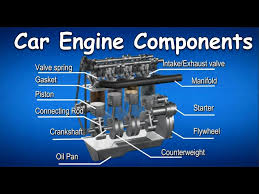Exploring the World of Engine Parts
Engines are complex machines made up of numerous parts that work together to generate power and drive vehicles. Each component plays a crucial role in ensuring the engine’s efficiency and performance. Let’s delve into the fascinating world of engine parts and understand their functions.
Pistons
The piston is a cylindrical component that moves up and down within the cylinder bore. It transfers force from expanding gas in the combustion chamber to the crankshaft, converting chemical energy into mechanical energy.
Cylinder Head
The cylinder head sits atop the cylinder block, sealing the combustion chamber and housing components such as valves, spark plugs, and fuel injectors. It plays a vital role in controlling airflow, fuel delivery, and exhaust gas removal.
Camshaft
The camshaft is responsible for operating the intake and exhaust valves at precise timings. It controls the opening and closing of valves to allow air-fuel mixture intake and exhaust gas expulsion during engine cycles.
Connecting Rods
Connecting rods link the pistons to the crankshaft, transmitting motion from pistons to rotate the crankshaft. They endure high stresses during engine operation and must be durable to withstand constant movement.
Crankshaft
The crankshaft converts linear motion from pistons into rotational motion that drives other engine components. It provides power output by turning rotational energy into torque for propelling vehicles.
Conclusion
Engine parts work harmoniously to create mechanical energy that powers vehicles. Understanding their functions helps appreciate the intricate design and engineering behind these essential components. From pistons to crankshafts, each part contributes to a well-oiled machine that propels us forward on our journeys.
Key Queries on Engine Components: Optimal Types, Core Parts, Constituents of a Car Engine, and Component Count
- Which engine type is best?
- What is the main parts of an engine?
- What parts make a car engine?
- How many engine parts are there?
Which engine type is best?
When it comes to determining the best engine type, there is no one-size-fits-all answer. The choice of engine type depends on various factors, including the vehicle’s intended use, fuel efficiency requirements, power output needs, and personal preferences. Different engine types, such as petrol, diesel, hybrid, and electric, offer unique advantages and drawbacks. Petrol engines are known for their smooth performance and affordability, while diesel engines excel in fuel efficiency and torque. Hybrid engines combine the benefits of petrol and electric power for improved efficiency. Electric engines are gaining popularity for their eco-friendliness and low maintenance costs. Ultimately, the best engine type is subjective and varies based on individual needs and priorities.
What is the main parts of an engine?
The main parts of an engine consist of several crucial components that work together to generate power and drive machinery. These include the pistons, which move up and down within the cylinder bore to transfer force to the crankshaft; the cylinder head, which houses valves, spark plugs, and fuel injectors while sealing the combustion chamber; the camshaft, responsible for precise valve timing control; connecting rods that link pistons to the crankshaft; and the crankshaft, converting linear motion into rotational energy to drive other engine parts. Each of these main components plays a vital role in the operation and performance of an engine, showcasing the intricate design and functionality behind this essential machinery.
What parts make a car engine?
A car engine comprises several essential parts that work together to generate power and propel the vehicle. Some key components include the pistons, cylinder head, camshaft, connecting rods, and crankshaft. The pistons move up and down within the cylinder bore, transferring force to the crankshaft and converting chemical energy into mechanical energy. The cylinder head houses valves, spark plugs, and fuel injectors, controlling airflow and combustion processes. The camshaft regulates valve operation for efficient intake and exhaust cycles. Connecting rods link pistons to the crankshaft, while the crankshaft converts linear motion into rotational energy for driving other engine parts. These components form a complex yet harmonious system that powers the car engine’s performance.
How many engine parts are there?
The question of how many engine parts there are is a common inquiry among those seeking to understand the complexity of engines. While the exact number of engine parts can vary depending on the type and design of the engine, a typical internal combustion engine can consist of hundreds, if not thousands, of individual components. From essential parts like pistons, cylinder heads, and crankshafts to intricate components such as valves, camshafts, and connecting rods, each piece plays a crucial role in the overall functioning of the engine. The intricate interplay of these parts highlights the meticulous engineering and precision required to create a powerful and efficient engine system.
Tags: airflow, camshaft, combustion chamber, connecting rods, crankshaft, cylinder head, engine parts, exhaust gas removal, fuel delivery, fuel injectors, mechanical energy, pistons, rotational motion, spark plugs, valves
